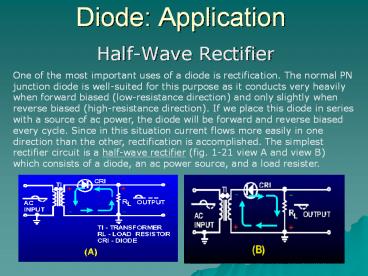Diode: Application PowerPoint PPT Presentation
1 / 21
Title: Diode: Application
1
Diode Application
- Half-Wave Rectifier
One of the most important uses of a diode is
rectification. The normal PN junction diode is
well-suited for this purpose as it conducts very
heavily when forward biased (low-resistance
direction) and only slightly when reverse biased
(high-resistance direction). If we place this
diode in series with a source of ac power, the
diode will be forward and reverse biased every
cycle. Since in this situation current flows more
easily in one direction than the other,
rectification is accomplished. The simplest
rectifier circuit is a half-wave rectifier (fig.
1-21 view A and view B) which consists of a
diode, an ac power source, and a load resister.
2
(No Transcript)
3
Diode Application
- The transformer (T1) in the figure provides
the ac input to the circuit the diode (CR1)
provides the rectification and the load resistor
(RL) serves two purposes it limits the amount of
current flow in the circuit to a safe level, and
it also develops the output signal because of the
current flow through it.
4
Rectification
- Before describing how this circuit operates,
the definition of the word "load" as it applies
to power supplies must be understood. Load is
defined as any device that draws current. A
device that draws little current is considered a
light load, whereas a device that draws a large
amount of current is a heavy load. Remember that
when we speak of "load," we are speaking about
the device that draws current from the power
source. This device may be a simple resistor, or
one or more complicated electronic circuits
5
Rectification
- During the positive half-cycle of the input
signal (solid line) in figure view A, the top of
the transformer is positive with respect to
ground. The dots on the transformer indicate
points of the same polarity. With this condition
the diode is forward biased, the depletion region
is narrow, the resistance of the diode is low,
and current flows through the circuit in the
direction of the solid lines. When this current
flows through the load resistor, it develops a
negative to positive voltage drop across it,
which appears as a positive voltage at the output
terminal.
6
Rectification
- However, if the diode is reversed as shown in
view B of figure , a negative output voltage
would be obtained. This is because the current
would be flowing from the top of RL toward the
bottom, making the output at the top of RL
negative with respect to the bottom or ground.
Because current flows in this circuit only during
half of the input cycle, it is called a half-wave
rectifier.
7
Full Wave Rectifier
8
Power Supplies
9
Capacitor Filter Circuit
10
Capacitor Filter Circuit
- Since practical values of C1 and RL ensure a
more or less gradual decrease of the discharge
voltage, a substantial charge remains on the
capacitor at the time of the next half cycle of
operation. As a result, no current can flow
through the diode until the rising ac input
voltage at the anode of the diode exceeds the
voltage on the charge remaining on C1. The charge
on C1 is the cathode potential of the diode. When
the potential on the anode exceeds the potential
on the cathode (the charge on C1), the diode
again conducts, and C1 begins to charge to
approximately the peak value of the applied
voltage.
11
Capacitor Filter Circuit
12
Capacitor Filter Circuit
- Operation of the simple capacitor filter using
a full-wave rectifier is basically the same as
that discussed for the half-wave rectifier.
Referring to figure 4-18, you should notice that
because one of the diodes is always conducting
on. either alternation, the filter capacitor
charges and discharges during each half cycle.
(Note that each diode conducts only for that
portion of time when the peak secondary voltage
is greater than the charge across the capacitor.)
13
Full Wave Rectifiers
14
Ripples filtering
15
Ripples Filter
16
Ripples Filter
17
Ripples Filter
18
Voltage Doubler
19
Voltage Doubler
When A is positive, D1 is forward biased and
charges C1 to the peak voltage, as in diagram 2.
D2 is reverse biased and does not conduct.
When A goes negative, D1 is reverse biased and
does not conduct. D2 is forward biased and
charges C2 to the peak voltage, as in diagram 3.
20
Voltage Doubler
simulation circuit
21
Voltage Doubler simulation results

